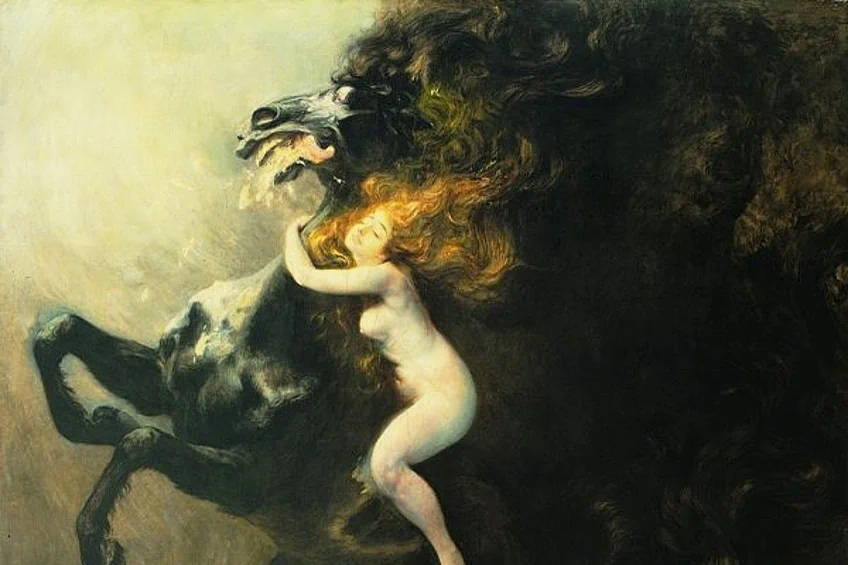Erotic Art – Discover How Artists Depict Sexuality in Art
Not-Safe-For-Work (NSFW) artwork is continually the topic of debate concerning the representation of sexually explicit content in art, most contested in the debate on what fine lines exist between soft pornography and erotic art. You are either an admirer of erotic art or you are against it and what it boils down to – either way, it is useful to understand the background of NSFW artwork and how it has progressed and remained in art history as an art form. This article will discuss the origin of erotic art, as well as look at the various displays of sexuality in art, erotic artists, erotic paintings, and all aspects of erotic fine art.
What Is Erotic Art?
In a general sense, erotic art is a broad term for the classification of a genre of artistic production that is made to arouse the viewer through the depiction of sexual acts and nudity. Like many genres in fine art history, erotic art also employs a variety of mediums, from film, engraving, and sculpture to drawing, painting, and photography. Many early works feature erotic themes across multiple cultures. Now that we have touched on a very broad definition of erotic art, we are going to look at the origin of erotic art.
Nudity is one aspect that is a common element of erotic art. Often thought of as taboo and essentialized as pornographic, erotic art is multifaceted.
The earliest forms of art that can be classified as erotic art is found in Paleolithic cave paintings, Mesolithic art, and Venus sculptures across Eurasia, Siberia, and Europe. As early as 7,200 years ago, a sculpture portraying a male and female partaking in sexual intercourse was discovered in 2005.

From what has been discovered, across multiple continents, it is clear that erotic art or erotic illustrations have fascinated man for thousands of years. Erotic art also forms part of the imagery in various cultures and religious practices. Some countries in Asia such as China, India, and Japan associate sexual acts with spiritual meaning. Moving from a religious-based narrative to an art-based genre, the ancient Greeks and Romans also included erotic images on ceramic sculptures and as décor since it was also a huge part of the early Greco-Roman culture.
Over the centuries, erotic art had progressed with more intensity, retaining its key purpose for pleasure but intensified via mass production and distribution.
Many are divided as to where one can draw the line between pornography and erotic art (or nudity as art). A simple distinction can be made by taking into consideration the kind of platform that erotic scenes take place. It would be typical to find erotic scenes in art and pornographic websites and literature – an interesting dynamic perhaps too much for the conservative critic to process.
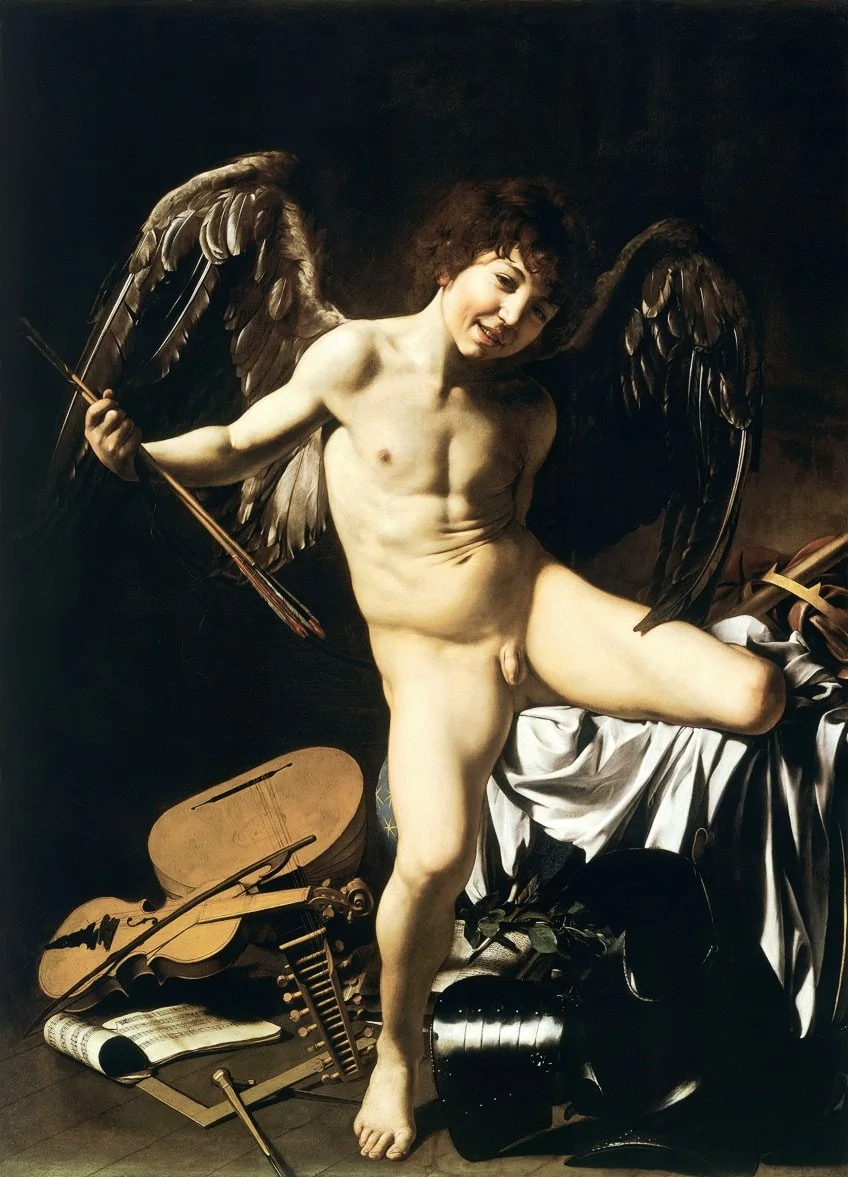
Is the definition of erotic itself problematic? What negative connotations do erotic art and the expression of sexuality in art carry? Does this diminish the value of erotic art as made by early skilled illustrators? Is nudity in Contemporary erotic art a critique of pornography or a simple performative gesture for one of the earliest and most widely common human acts, sex?
These are all important questions to ask yourself when assessing your stance on erotic art.
Erotic Symbolism in Art: Intention
In most early forms of erotic art, the illustration of nudity with a hyperfocus on genitalia is considered symbolic. In some cultures, the phallus is symbolic of potency and not seen in an erotic manner. The majority of erotic art depicts sexual intercourse, which is known to fixate on the genitalia of the individuals portrayed, their facial expressions, the movement of their bodies, and as if the viewer is suddenly witnessing two individuals having sex. The symbolism in erotic art alludes to multiple things.
This ranges from an appreciation of the function of reproduction, that is, creation, to an appreciation of the male or female form with the artistic intention of inducing arousal, pleasure, and satisfaction in the viewer.
Other intentions behind producing sexual artwork not only revolve around the sexual arousal of the viewer but can be interpreted through a lens of critique on pornographic imagery and more specifically, the feeling evoked by the viewer.
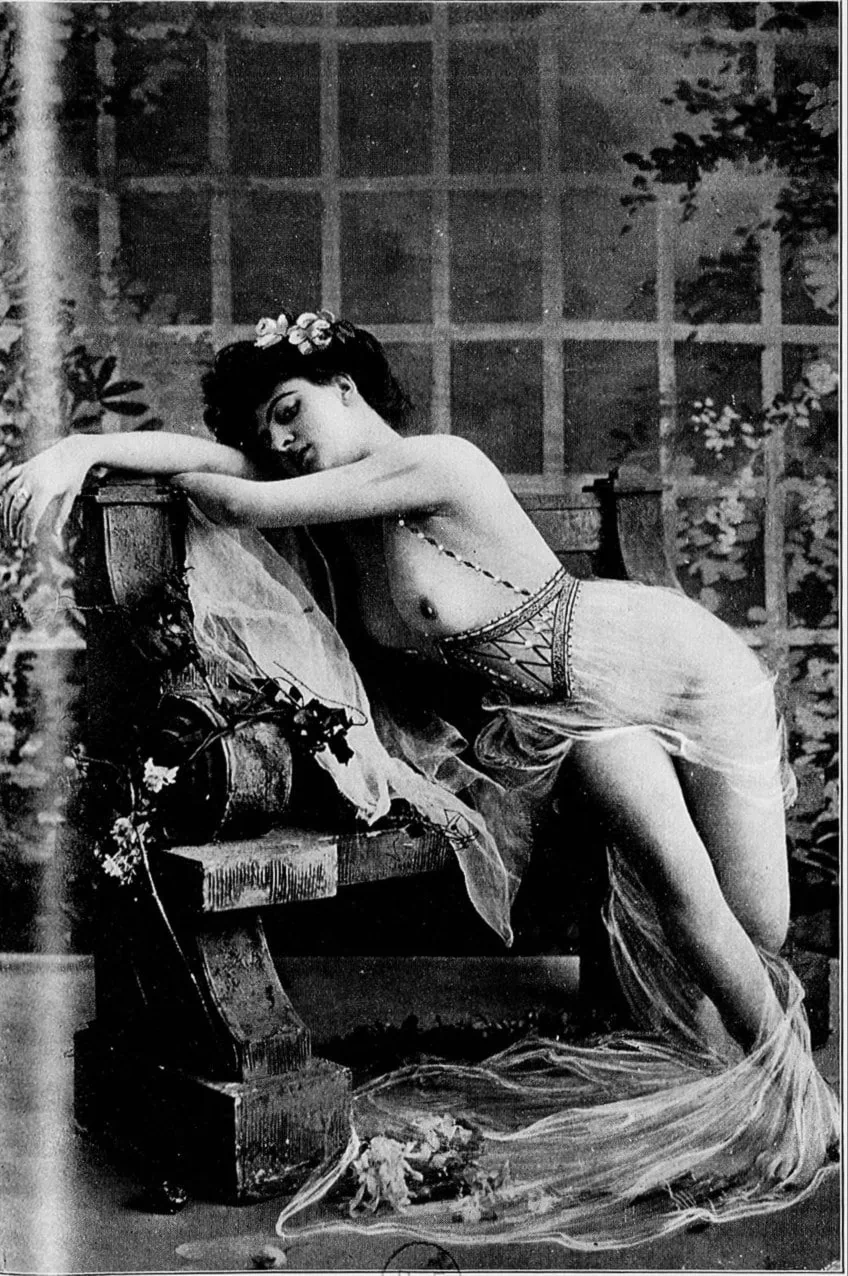
Simply put, the intention behind erotic art can either please you or make you uncomfortable with the idea of witnessing the human nude in an act that is commonly performed in private. Art is public when exhibited and made for exhibition but when art contains erotic imagery for exhibition, it comes with more questions on what can be exhibited or what limits exist, if any, on the exhibition of explicit imagery.
Some have attributed the criticism of erotic art as “too explicit” or “easy art” as stemming from individuals who are uncomfortable with sexuality and the display of “private acts”.
Erotic Art Around the World
Early art utilized erotic imagery as part of décor and nudity was seen as an “early art form”. The shift in the depiction of nudity in conjunction with modernity and the increase in censorship go hand in hand with the evolution of erotic art and the way that humans have perceived art. Below we will examine the different forms of erotic art as captured by different cultures across the world.
Ancient Greek and Rome
Paintings of sexual scenes can be found on ceramic objects and are regarded as the earliest representations of same-sex relationships. Some sexual scenes depict pederasty, which is the sexual act between an older male and an adolescent male. Symbolic sculptures of phalli were discovered in temples and other places of worship, including the temple of Delos and Dionysus.
The phallus as a symbol also took on the role of a common object for protection in most households, featured on statues with a head placed on a plinth and a phallus in front.
One can say that the Greeks were sexually open to the ideals of same-sex erotic art, the first lesbian depiction in erotic art was found in Hymn to Aphrodite (late 6th to 7th century BCE) by Greek poet, Sappho. An interesting thought to ponder over is the basis of morality of the ancient Greeks and if there was any actual concept of pornography about morality. It seemed to be part of everyday life, as is the act of sexual intercourse, so why is nudity censored in art today?
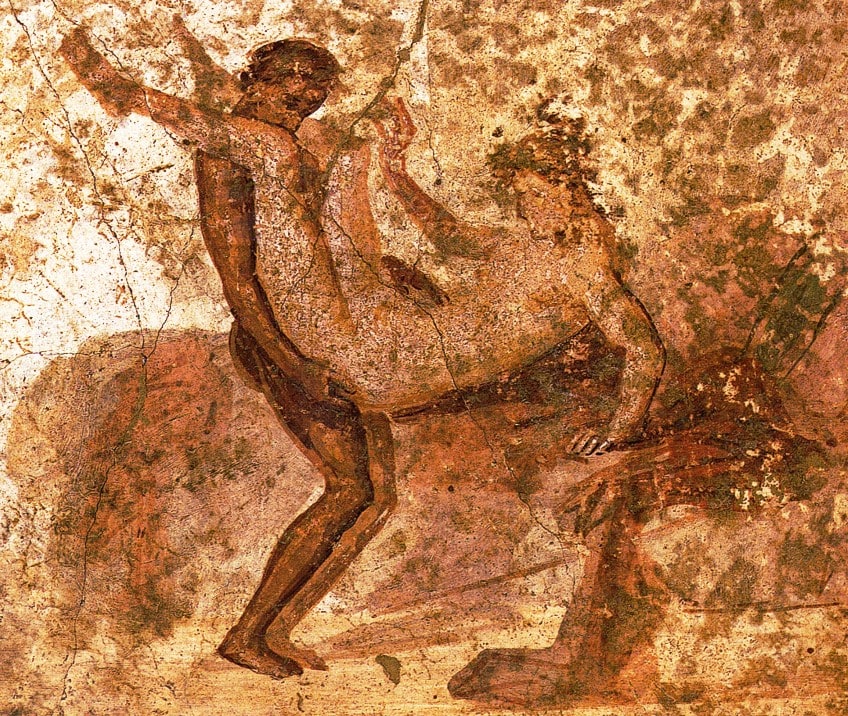
In Rome, explicit erotic art can be found in many sculptures and paintings from ancient ruins across the Villa of the Mysteries and Pompeii. The purpose of erotic art here differs since some erotic art carried ritualistic meaning. In one such example at the Villa of the Mysteries, you can find a depiction of a flagellation scene, which was part of a cult practice and carries more religious meaning than sexual intention. Location is also key since another site at a brothel revealed sexually graphic paintings serving as an advertisement for the brothel’s services.
In addition to decorative functions, the phallus as a symbol in Rome served as a beacon engraved on sidewalks to help visitors locate entertainment and prostitution districts.
Sex was a large part of cultural practice so it made sense that it was celebrated as an art form through erotic art. In 1999, the British Museum came into possession of a silver Roman cup called the Warren cup, which depicts same-sex relations of two males on its relief. This well-crafted art object was purchased for a massive £1.8 million and dated to the first century AD.
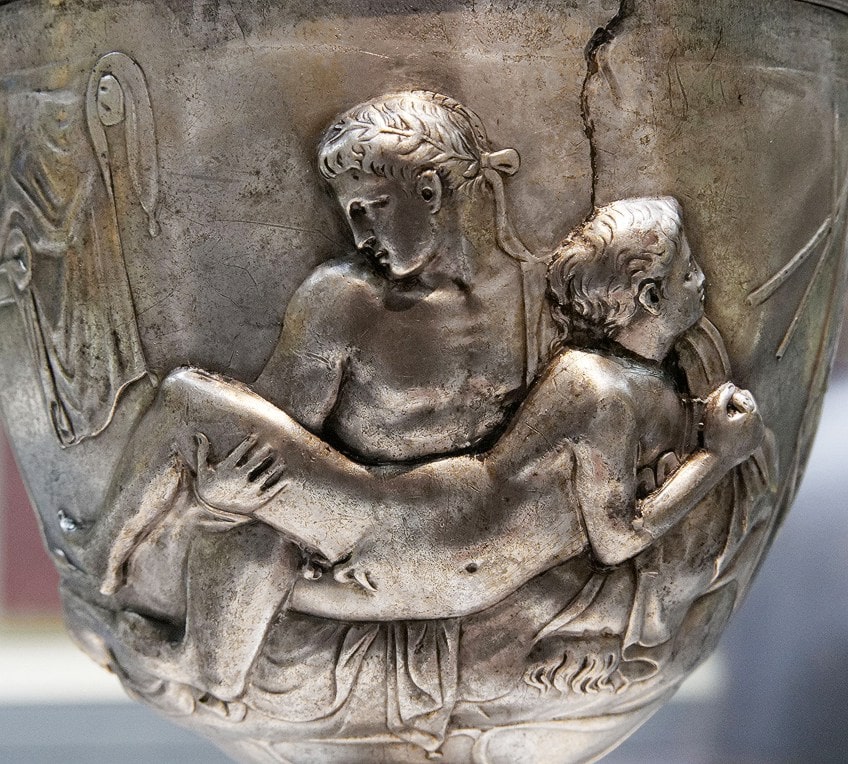
Certain sexual acts were considered “taboo”, and perhaps where the Romans drew the line, was the depiction of oral sex. This was depicted more so for humor rather than décor and gives us an indication of the scope of erotic art, as seen through the eyes of the ancient Romans. Early sexual artwork also features bestiality, defined as the depiction of sexual intercourse or activity between humans and non-human animals. An example is the God of the wild, Pan, engaging in sexual intercourse with a goat.
This excavation was considered so obscene that it was hidden away and only exhibited to the public in 2000. This artwork is now located at the Secret Museum in Naples, Italy.
Erotic Art in Egypt
Although not at the forefront of ancient Egyptian art, erotic art can be found in rudimentary drawings with depictions of sexual acts on pottery and the form of graffiti. In fact, the world’s first erotic magazine, presumably for men, was discovered in 1150 BC in Deir el-Medina around the early 1900s.
The “magazine” is called the Turin Erotic Papyrus, also known as Papyrus 55001, and measures approximately 2.6 meters by 25 centimeters divided into two parts.
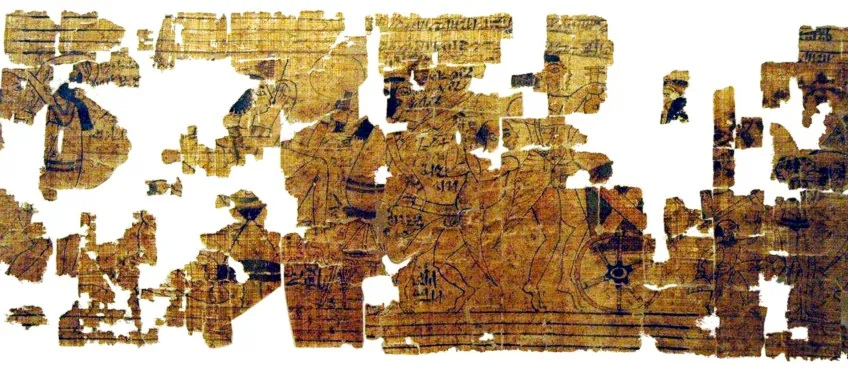
One section of the papyrus consists of 12 erotic vignettes showing multiple sex positions enacted by men and women. In the drawings, the men are depicted with exaggerated genitalia and are often characterized by baldness, old age, and ragged-looking features. In stark opposition, the women are shown as nubile and often feature objects associated with erotic iconographies such as monkeys and lotus flowers.
The papyrus is now located in Italy at the Museo Egizio. It was concluded that the artwork was made for a wealthy audience since the quality of the artwork was so high.
Erotic Art in Asia
In many early Asian cultures, sex was celebrated. A well-known form of erotic art from Japan, called Shunga, was extremely popular and common back in the day. The term Shunga is a Japanese word that refers to erotic art and translates to spring pictures. A lot of Shunga depicts erotic imagery associated with spring flowers to symbolize the perceived limit on female beauty and fertility.
It was found that erotic imagery also existed long before Shunga, in the Han and Tang dynasties of China.
Although the idea of erotic content originated in China, the Japanese decided to reproduce erotic art and invent their own cultural rendition. When Shunga first emerged around the Heian period, it was not very accessible and it was mostly owned by members of the upper class. After wood-block printing was developed, the idea of mass production and copies took off and Shunga thrived in the Edo era. Following Shunga’s integration and acceptance into society, erotic art soon became a gift-giving language and was considered a souvenir or memento of Edo.
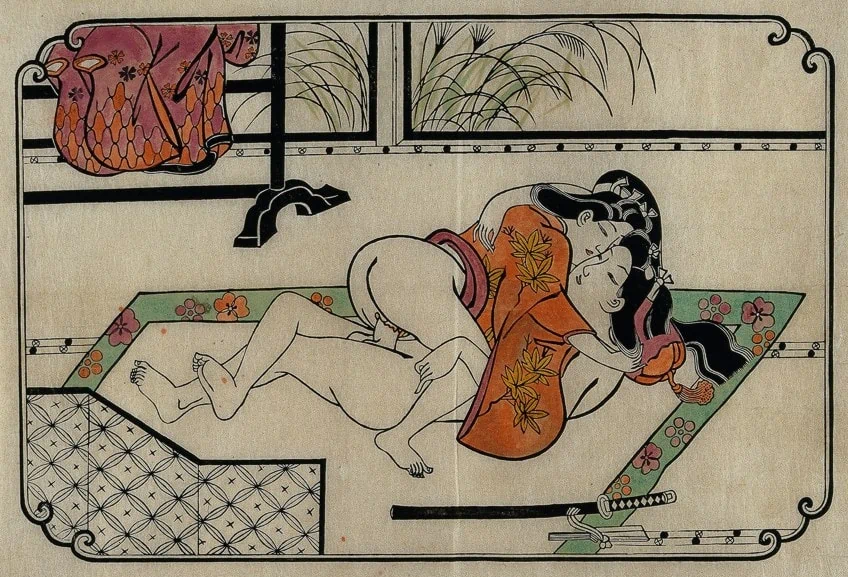
Shunga was also considered a symbol for rain and associated with the unification of the Yin and the Yang through the act of sex. This was further symbolic of fertility and likened to rain that brought fertility to the land. Shunga literature was kept as a symbol of protection in many households, as a safeguard against potential fires. Some individuals were also superstitious to the point that they believed Shunga was a lucky charm for the prevention of death.
Shunga was also an important tool for early sex education, normally gifted to newlywed couples and brides of wealthy families to learn from and prepare for the act.
When the Kyōhō reform was introduced in 1722, many Shunga publications moved “underground” and the Tokugawa shogunate placed a ban on any unauthorized literature. Erotic photography soon emerged along with the introduction of Western technology in the Meiji era around 1868 and saw Shunga’s popularity decline.
Erotic Art in Europe
During the Renaissance, there was a demand for erotic illustration solely for the pleasure and entertainment of aristocrats. I Modi was a woodcut album designed by Giulio Romano, Pietro Aretino, and Marcantonio Raimondi, which consisted of explicit scenes depicting sexual acts between well-known historical couples and mythological figures. This text was banned by members of the Vatican for its content and the album eventually fell into the possession of Raimondi, who happened to be the student of Raphael.
In Italy, this erotic display was considered extremely taboo and the book was ordered by Pope Clement to be destroyed.
Raimondi reproduced the book and was soon arrested for the reproduction and dissemination of erotic imagery. Often called “Renaissance Pornography”, many 16th-century artists gave rise to productions containing imagery of nude female figures. For Greek culture, the idea of the nude was a symbol of elitism and racial supremacy, with the female nude symbolizing fertility, love, and sexuality, and the male nude symbolizing mankind, heroism, and virtue.

While nudity in some art forms like sculpture was considered the norm, it was interpreted as sinful, shameful, and a symbol of poverty in medieval Christianity. The acceptance of the nude progressed through art in an attempt to integrate the ideals of Christianity with the female nude and under the guise of “artistic mastery” over the subject.
The erotic nude was still a revolutionary concept at the time for Northern Europe but this soon ended with the Italian painter, Giorgione, who created Laura: Portrait of a Woman (1506), which was an erotic portrait, presumed to be commissioned for the aristocracy.
Famous Erotic Paintings
Now that we have covered a brief overview of the different manifestations of erotic art across the globe, we can focus specifically on artworks. Below, we will be looking at a few examples of some of the most famous erotic paintings in the world.
Venus of Urbino (1534) by Titian
| Artist | Titian |
| Date | 1534 |
| Medium | Oil on canvas |
| Dimensions (cm) | 119 x 165 |
| Where It Is Housed | Uffizi, Florence |
Also known as the “reclining Venus”, Titian’s Venus of Urbino (1534) was considered to be one of the “vilest” paintings in the world, as stated by Mark Twain. Seen as “undeniably erotic”, this nude compared to Hokusai’s The Dream of the Fisherman’s Wife seems to be more conservative. Venus’ direct gaze from the confines of a Renaissance palace is inviting and seductive.
The female is seen as embracing her sexuality and this painting can be considered somewhat revolutionary as some have speculated that the woman in the painting was most likely engaging in masturbation.

La Maja Desnuda (c. 1797 – 1800) by Francisco de Goya
| Artist | Francisco de Goya |
| Date | c. 1797 – 1800 |
| Medium | Oil on canvas |
| Dimensions (cm) | 97 x 190 |
| Where It Is Housed | Museu del Prado, Madrid |
The reclining nude is a famous trope of Renaissance nude painting and Francisco de Goya’s reclining nude in La maja desnuda delivers. The delicate painting is a Romantic rendition of the reclining nude and is recognized as one of the earliest Western paintings to portray a naked woman and the presence of pubic hair in a positive light, as opposed to the presence of pubic hair in paintings of prostitutes.

The nude woman’s gaze is direct and this is what made the painting stand out in its time. De Goya did cause a bit of an upheaval with the ecclesiastic authorities but he also set the precedence for the depiction of female nudes in art.
The artwork is currently housed at the Museu del Prado in Spain since its acquisition in 1901.
The Dream of the Fisherman’s Wife (1814) by Katsushika Hokusai
| Artist | Katsushika Hokusai |
| Date | 1814 |
| Medium | Woodblock print |
| Dimensions (cm) | 18.1 x 25.7 |
| Where It Is Housed | Ronin Gallery, New York |
This is one of the most famous examples of erotic art derived from Shunga. Katsushika Hokusai is renowned for his iconic woodblock print, Under the Wave off Kanagawa (c. 1830-1832), which depicts a crashing wave witnessed by Hokusai from the Edo period.
In The Dream of the Fisherman’s Wife, Hokusai depicts a female diver who is receiving oral sex from an octopus who is wrapped around the woman’s body.
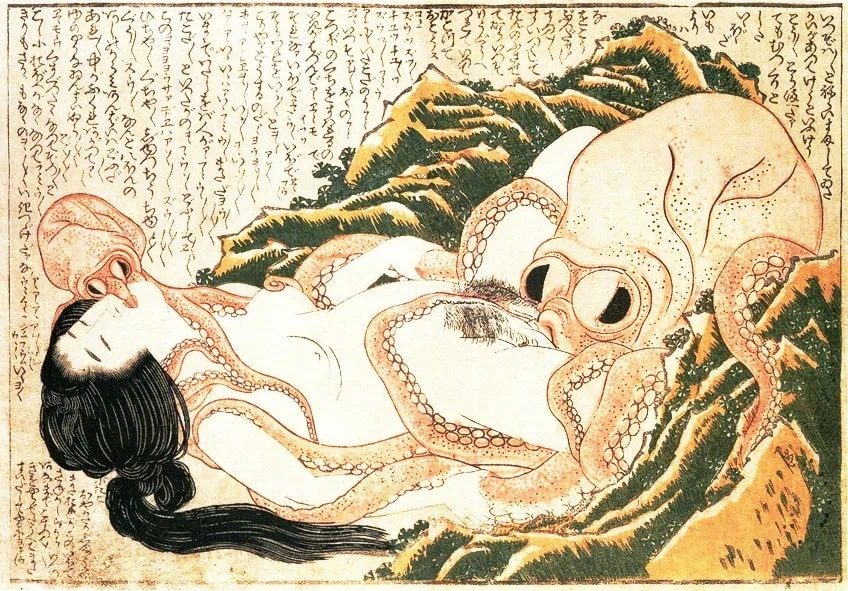
The tale behind the print involves the legend of a shell diver, Princess Tamatori, who embarked on a brave mission to retrieve a pearl from the water dragon’s den under the sea. The erotic nature of Hokusai’s The Dream of the Fisherman’s Wife even influenced Pablo Picasso, who rendered his own version of the story.
Olympia (1863) by Édouard Manet
| Artist | Édouard Manet |
| Date | 1863 |
| Medium | Oil on canvas |
| Dimensions (cm) | 190 x 130 |
| Where It Is Housed | Musée d’Orsay, Paris |
Inspired by Titian and Goya’s erotic paintings, Édouard Manet created Olympia, which upon its first public exhibition, received much criticism for the depiction of a sex worker in such a “scandalous” manner. What makes Olympia so special is that she is portrayed as comfortable in her career as a sex worker, as a woman who is satisfied with her job, and is unashamed to gaze directly at the viewer as her assistant brings her a gift of flowers to her bedside.
Olympia has been the subject of intense analysis by many art historians, especially in comparison to Sandro Botticelli’s The Birth of Venus (c. 1484 – 1486) and their depictions of the nude woman in comparison to the Roman Goddess, Venus.

L’Origine du monde (1866) by Gustave Courbet
| Artist | Gustave Courbet |
| Date | 1866 |
| Medium | Oil on canvas |
| Dimensions (cm) | 46 x 55 |
| Where It Is Housed | Musée d’Orsay, Paris |
This extremely detailed painting speaks for itself. There is no illusion, only eroticism as Gustave Courbet explicitly sets out in L’Origine du monde, which translates to “the origin of the world”. It had been speculated that the woman who modeled for this painting was engaged in an affair with Courbet himself since she was known to be in a relationship with one of Courbet’s close friends.
Perhaps driven by the desire for another man’s woman, Courbet painted L’Origine du monde.

However, the painting was believed to be commissioned by the Ottoman diplomat, Khalil Bey, who was already a collector of erotic work. Khalil Bey could not hold onto his paintings and due to his financial turmoil, his paintings became the occupant of various private collections.
Frenzy of Exultations (1893) by Władysław Podkowiński
| Artist | Władysław Podkowiński |
| Date | 1893 |
| Medium | Oil on canvas |
| Dimensions (cm) | 310 x 270 |
| Where It Is Housed | Sukiennice Museum, Kraków |
Recognized as a classical piece, this oil painting depicts the expression of unbound sexuality coupled with intense passion. A nude woman is seen clinging onto a wild horse that seems to be stricken with madness. The intense scene caused quite the scandal for the Polish artist at the time and illustrated the possessed nature that erotic fantasies can evoke.
A poet by the name of Kazimierz Tetmajer made a statement on the work saying that as young artists who paint and write, Podkowiński’s work was most welcome and that his “work demolished all schemas with the greatest of joys.”

Frau Bei Der Selbstbefriedigung (1913) by Gustav Klimt
| Artist | Gustav Klimt |
| Date | 1913 |
| Medium | Drawing |
| Dimensions (cm) | Not available |
| Where It Is Housed | Not available |
The erotic drawing, Seated Woman Masturbating by Gustav Klimt is quite clear in its intent and leaves no room for further discussion of what the drawing means. As the title situates it, the drawing shows a seated woman partaking in self-pleasure. Klimt’s use of white chalk to draw attention to the negative space showing the woman’s genitals is clever as it puts into focus the key theme of the drawing.
Most erotic artworks depicted women and men engaging in sexual acts so for Klimt to depict the personal image of a woman masturbating was unique and introduced different ways of “seeing” in erotic art.
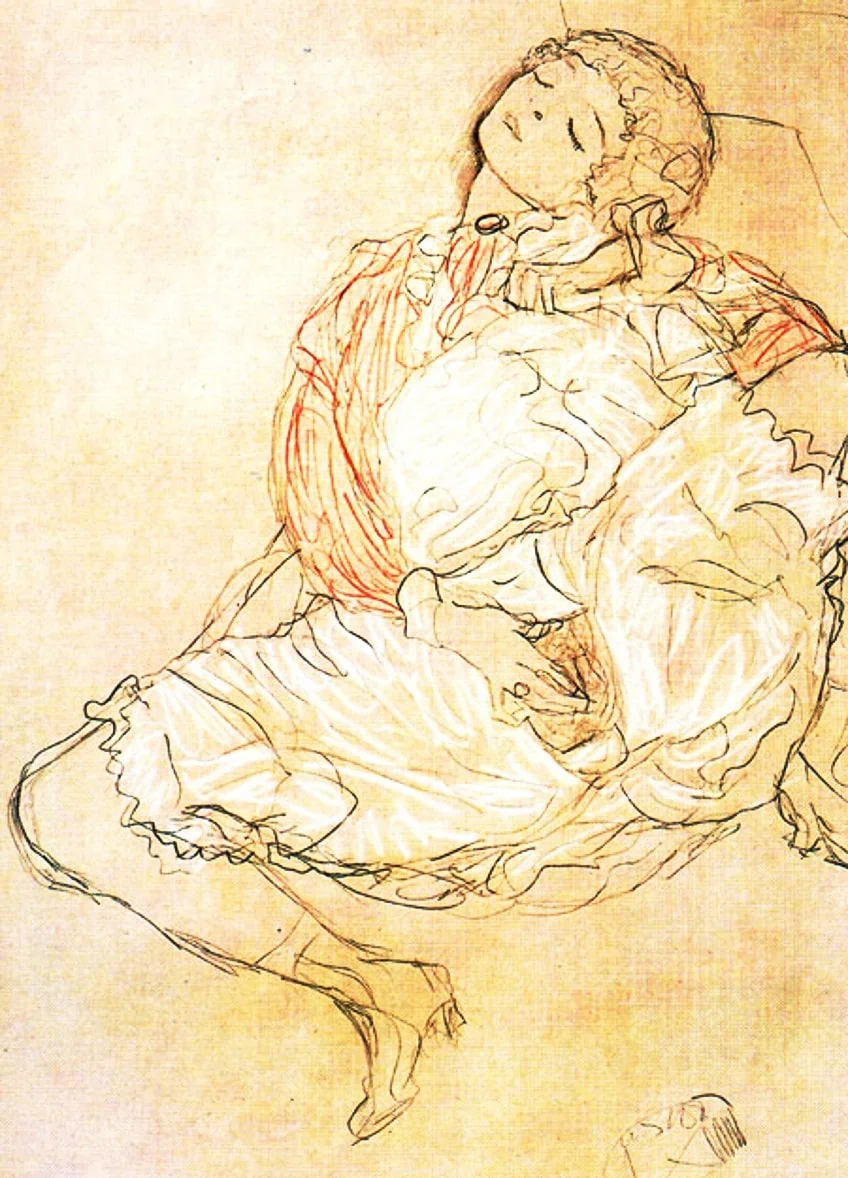
Erotic Art of the 20th Century
Erotic fine art photography soon replaced the traditional mediums of erotic art and allowed for the widespread distribution of erotic imagery. The early 20th century erotic art phase was more so an exploration of the representation of eroticism captured through Futurism, German Expressionism, and Cubism.
The representation of erotic imagery shifted towards Surrealism and Realism by the middle of the 20th century and was also subject to experimentation, as per the guidelines of the art movements.
At this point, the ideas of erotic fantasy were rife and marked the emergence of eroticism in the unconscious and dream environment. Below are a few examples of erotic artwork captured by artists of the 20th century. Other erotic artists include Egon Schiele, Louis Daguerre, Édouard-Henri Avril, Shaykh Muhammad Ibn Mustafa Al-Misri, Francis Picabia, Guido Reni, Wolfgang Tillmans, and Mickalene Thomas.
Pleiades (1921) by Max Ernst
| Artist | Max Ernst |
| Date | 1921 |
| Medium | Oil on canvas |
| Dimensions (cm) | 25 x 18 |
| Where It Is Housed | Private collection |
Surrealist Max Ernst created Pleiades as a means of removing himself from the conventional approach toward sexuality. In the painting, Ernst used a photograph of a nude woman without a head suspended in the air between what appears to be the sky or a reference to water.
The woman is said to represent one of the companions of the God of the Moon and the hunt, Artemis.
The nymph is floating for the very reason that she is meant to be free from social expectations – to find freedom in her nakedness. The painting is also called Approaching Puberty and can be seen as an erotic artwork for sexual emancipation.
Double Nude Portrait (1937) by Sir Stanley Spencer
| Artist | Sir Stanley Spencer |
| Date | 1937 |
| Medium | Oil on canvas |
| Dimensions (cm) | 83.8 x 93.7 |
| Where It Is Housed | Private collection |
Also known as Leg of Mutton Nude, Sir Stanley Spencer depicts himself towering over the naked body of his second wife, Patricia Preece. The painting was created in the same year he married her; however, the painting shows that there is some form of distance present between the artist and his wife.
The supposed intimacy between a husband and his wife is not as warm and “loving” as one might expect to find. This discomfort is what makes the painting stand out, aside from being an NSFW artwork.
Another curious feature is the leg of mutton that is placed so casually next to Patricia. The colors on the leg of mutton match the colors that Spencer uses to paint his skin and is an odd choice – perhaps the discomfort was too uncanny for Spencer and he instead decided to portray the nude piece of mutton as the subject of discomfort.
This also serves as the distraction from the equal discomfort the viewer encounters by witnessing the artist observing his wife.
Flesh Wall – Female (1965) by Martha Edelheit
| Artist | Martha Edelheit |
| Date | 1965 |
| Medium | Oil on canvas |
| Dimensions (cm) | 203.2 x 495.3 |
| Where It Is Housed | Eric Firestone Gallery |
Martha Edelheit is considered one of the most important female artists in erotic contemporary art of the 1960s. Edelheit was known for her ability to challenge the norms through the incorporation of “quotidian materials” that draw reference to tattoos on women and non-Western erotica.
In her Flesh Wall series, Martha Edelheit portrays a group of circus performers who are engaged in an erotic assemblage coupled with paper dolls to create an adult fantasy that traverses sexual costuming, sadomasochism, and gender identity.
Flesh Wall is spread out across three panels, showcasing various nude women in different erotic and sexually suggestive positions.
Untitled (The Birth Series) (1968) by Kishin Shinoyama
| Artist | Kishin Shinoyama |
| Date | 1968 |
| Medium | Photography |
| Dimensions (cm) | 25.4 x 24.7 |
| Where It Is Housed | Aki Gallery |
Known as one of Japan’s most famous photographers, Kishin Shinoyama is a remarkable artist and creator of nude photo books. Untitled (The Birth Series) (1968) is part of his series of photographs that he shot on a beach in Okinawa, Japan.
This series is known to be the artist’s pivotal production, having been exhibited at the 1968 Ginza Nikon Salon. In the photograph, a woman is seen resting on the torso of a man with her hand resting on his hip while she gazes up at the third invisible subject.
The man appears to have goosebumps on his skin and the erotic nature is evoked not only by the woman’s gaze but by the assumption that it is her touch that brought goosebumps to the man’s skin. This intimate photograph was captured beautifully in monochrome black and white. Other famous erotic photography artists include Sam Haskins, Francis Giacobetti, Cam Attree, Gary Breckheimer, and Reka Nyari.
The Turkish Bath (1973) by Sylvia Sleigh
| Artist | Sylvia Sleigh |
| Date | 1973 |
| Medium | Oil on canvas |
| Dimensions (cm) | 83.8 x 93.7 |
| Where It Is Housed | Paul and Miriam Kirkley Fund, The David and Alfred Smart Museum of Art |
Imagine the subversion of the reclining Venus and the idea of the female nude but using a nude male model? Sylvia Sleigh cleverly painted The Turkish Bath using male models, serving as a resistance to the objectification of women and a subversion of the male gaze. Classified as an erotic painting made for women, Sleigh makes use of imagery of nude men.
You may think that this is a jab at the male body and in fact the objectification of men as a fight against the objectification of women, but this is not the case.
Sleigh stated that her work was not to replicate the idea of historical paintings in depicting men as a way to get back at the injustices of art, rather she “painted them as portraits, not as sex objects”. Her models were close associates who she so skillfully captured through the details in the painting. This can be seen through the detail in the men’s hair and even their birthmarks.
She also integrated different objects and still lifes in the painting to direct the attention to her sitters’ personalities.
Unconventional Erotic Artworks
When examining the purpose of erotic artwork, one can conclude that its primary role may be to stimulate the viewer in a sexual manner but the details of what that stimulation entails can be broken down further. According to American philosopher, Guy Sircello, sexual stimulation involves inducing a sexual feeling in either “our sexual parts” or other erogenous areas that are regarded as pleasant.
Matthew Kieran offers another definition, stating that erotic art aims to elicit sexual feelings, thoughts, and other effects that are associated with arousal.
Normally, we would find that erotic art contains much nudity but a few artworks, such as the notable examples listed below, can be considered artworks that do not necessarily speak directly toward erotic art but rather allude to its purpose.
The Prayer (1930) by Man Ray
| Artist | Man Ray |
| Date | 1930 |
| Medium | Gelatin silver print |
| Dimensions (cm) | 24 x 18.1 |
| Where It Is Housed | Getty Museum collection |
The famous Dada and Surrealist influencer, Man Ray, has been a pioneer of evocative photography since the seventies. The Prayer is a photographic print of his that stimulates the viewer through an unconventional approach to sexual arousal.
Featured in the print is an unusually angled image of an individual, photographed from behind in a “child’s pose” position that emphasized the buttocks of the subject for the “shock effect”.
It is interesting that Ray does not focus on the specific gender of the subject but the simple suggestion of a figure laying in a “prayer-like” state, in prostration, suggests a theme of submission. The theme of submission crosses between a very non-sexual practice of prayer and finds its way into sexuality and submission, as seen through sex.
The Look from Erotos (1993) by Nobuyoshi Araki
| Artist | Nobuyoshi Araki |
| Date | 1993 |
| Medium | Gelatin silver print |
| Dimensions (cm) | Varied sizes |
| Where It Is Housed | Private collection |
Another unconventional approach to sexual art is Nobuyoshi Araki’s The Look from Erotos, which leveraged a close-up of a human eye to evoke a sensual expression of lust and desire. The complete negation of nudity was replaced with a more intimate area that stimulated erogenous zones – eye contact and the lustful gaze.
This new inquiry into what defined erotic art can range from a direct approach depicting intense sexual scenes to subtle expressions and still moments, aided by photography.
The issue of art meeting the criticism of pornography emerged in 1857, followed by many restrictions on the exhibition of explicit imagery. From the multiple accounts of erotic art across the world seen above, it seems that it is vital to consider the foundational questions of how one defines what is erotic, does the exhibition of erotic art make art inaccessible (or perhaps inappropriate) for viewers who fall in the younger age groups, and what forms of censorship exist in your country that prohibit or inhibit the exhibition of sexual art? These are important points for consideration, especially if you are interested in adopting erotic art into your art practice.
Frequently Asked Questions
What Is Erotic Art?
Erotic art can be defined as any artwork produced with the intention of eliciting a sexual feeling of arousal from the viewer or stimulating a viewer’s erogenous zones. Erotic art can be characterized by the depiction of nude imagery or visuals that allude to sexuality, sexual expression, lust, desire, and sexual acts.
What Is the Difference Between Erotic Art and Pornographic Imagery?
The main difference between erotic art and pornography is the intention and platform. Although the intention of feeling for the viewer may be similar, the intention of usage and production differs in that erotic art is produced for display in art-specific locations and for art exhibition purposes – not for mainstream media, although mistaken for pornographic intent. Pornography is widely distributed on pornographic sites on the internet with the sole purpose of commercialization and the viewer’s pleasure. It can be complex to distinguish between the two since they both share similar traits; however, erotic art can be said to be confined to the art sector.
When Did Erotic Art First Appear?
Erotic art as a genre can be said to have begun around 1490 with the illustration of the Vitruvian Man (c. 1490) by Leonardo da Vinci, as well as the works of Sandro Botticelli and Michelangelo.
Jordan Anthony is a Cape Town-based film photographer, curator, and arts writer. She holds a Bachelor of Art in Fine Arts from the University of the Witwatersrand, Johannesburg, where she explored themes like healing, identity, dreams, and intuitive creation in her Contemporary art practice. Jordan has collaborated with various local art institutions, including the KZNSA Gallery in Durban, the Turbine Art Fair, and the Wits Art Museum. Her photography focuses on abstract color manipulations, portraiture, candid shots, and urban landscapes. She’s intrigued by philosophy, memory, and esotericism, drawing inspiration from Surrealism, Fluxus, and ancient civilizations, as well as childhood influences and found objects. Jordan is working for artfilemagazine since 2022 and writes blog posts about art history and photography.
Learn more about Jordan Anthony and about us.
Cite this Article
Jordan, Anthony, “Erotic Art – Discover How Artists Depict Sexuality in Art.” artfilemagazine – Your Online Art Source. August 17, 2022. URL: https://artfilemagazine.com/erotic-art/
Anthony, J. (2022, 17 August). Erotic Art – Discover How Artists Depict Sexuality in Art. artfilemagazine – Your Online Art Source. https://artfilemagazine.com/erotic-art/
Anthony, Jordan. “Erotic Art – Discover How Artists Depict Sexuality in Art.” artfilemagazine – Your Online Art Source, August 17, 2022. https://artfilemagazine.com/erotic-art/.


